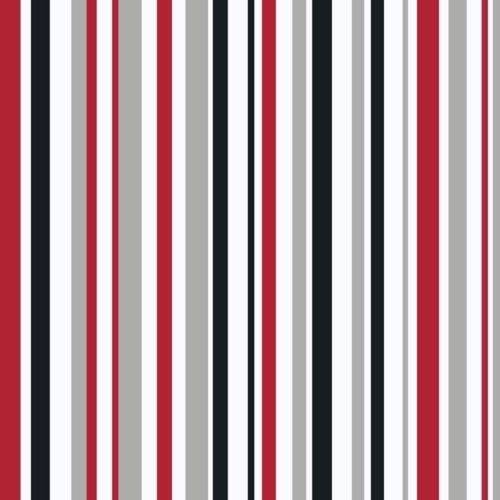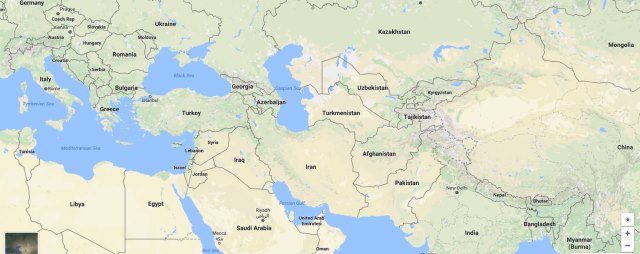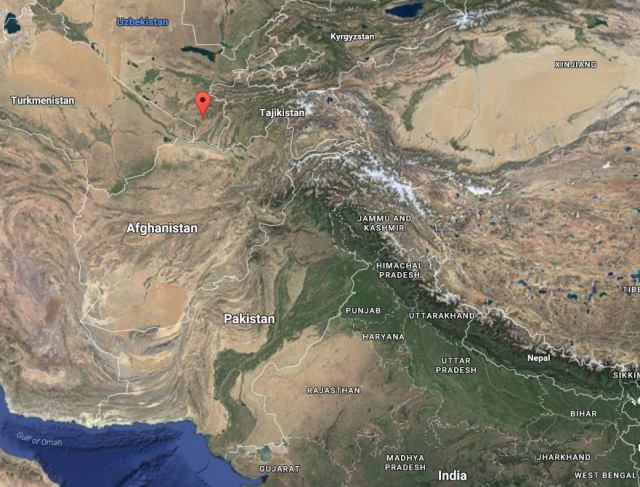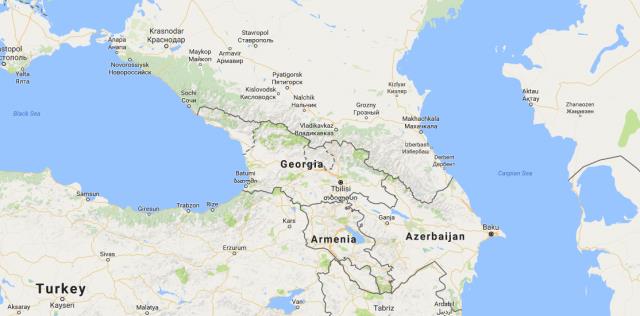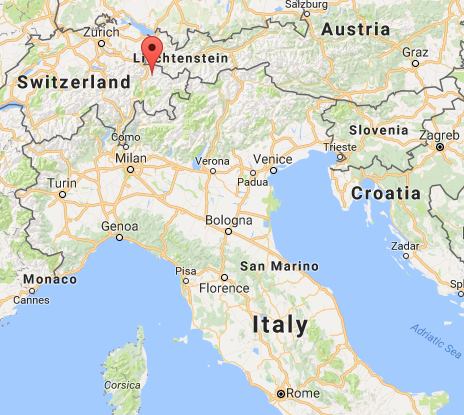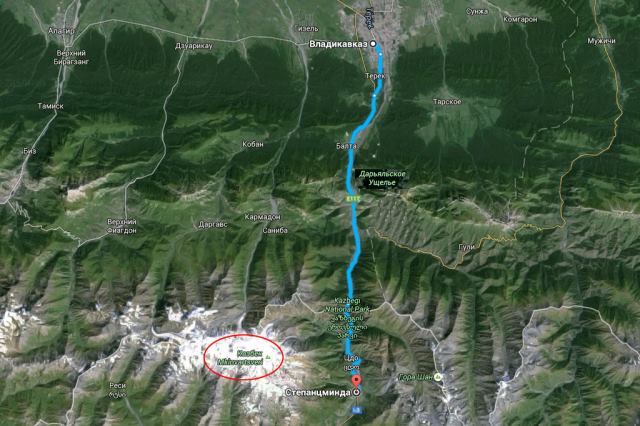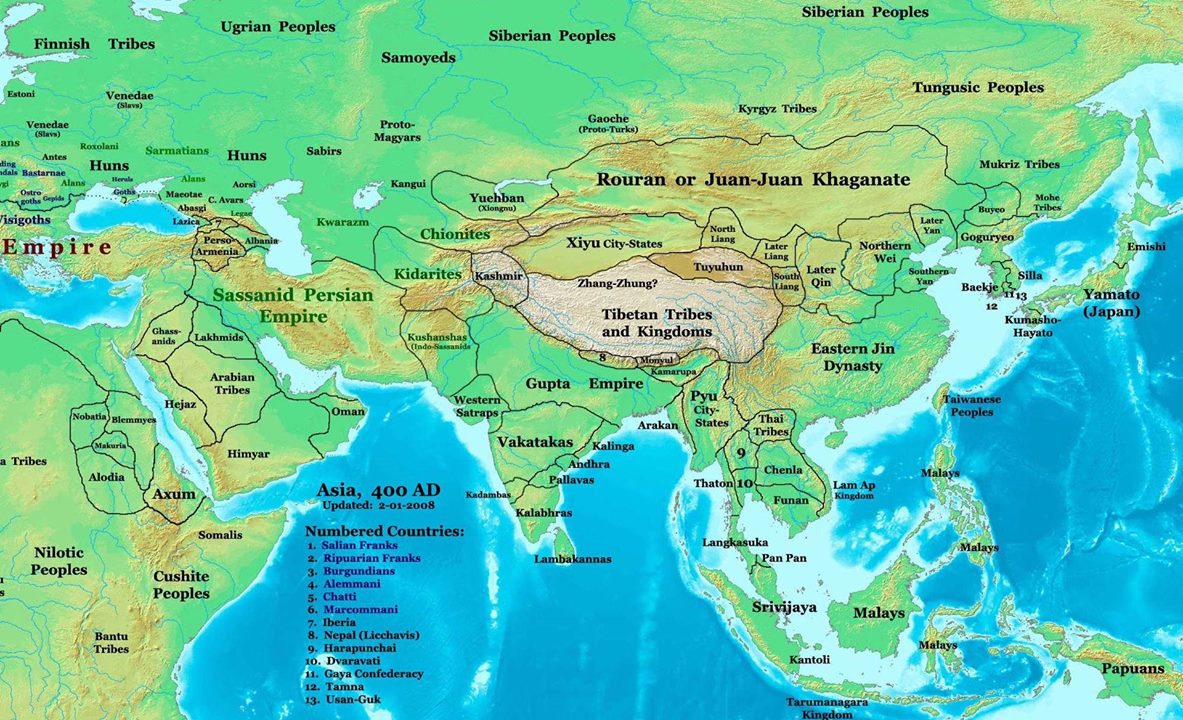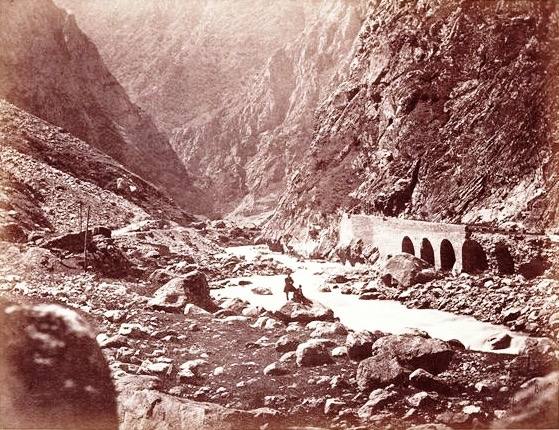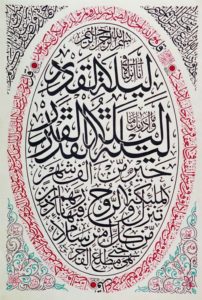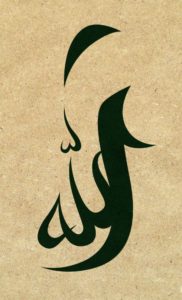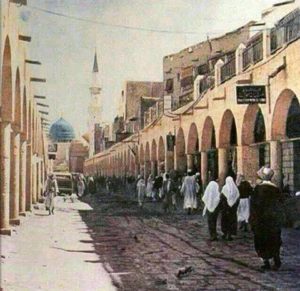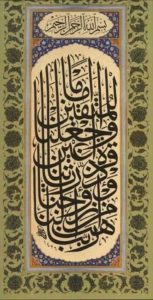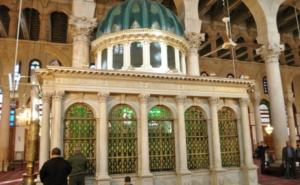Imam Nawawi’s 40 Hadith
 1] It is narrated on the authority of Amirul Mu’minin, Abu Hafs ‘Umar bin al-Khattab (ra) who said:
1] It is narrated on the authority of Amirul Mu’minin, Abu Hafs ‘Umar bin al-Khattab (ra) who said:
I heard the Messenger of Allah (ﷺ) say: “Actions are (judged) by motives (niyyah), so each man will have what he intended. Thus, he whose migration (hijrah) was to Allah and His Messenger, his migration is to Allah and His Messenger; but he whose migration was for some worldly thing he might gain, or for a wife he might marry, his migration is to that for which he migrated.” [Bukhari &Muslim]
عَنْ أَمِيرِ الْمُؤْمِنِينَ أَبِي حَفْصٍ عُمَرَ بْنِ الْخَطَّابِ رَضِيَ اللهُ عَنْهُ قَالَ: سَمِعْتُ رَسُولَ اللَّهِ صلى الله عليه وسلم يَقُولُ: ” إنَّمَا الْأَعْمَالُ بِالنِّيَّاتِ، وَإِنَّمَا لِكُلِّ امْرِئٍ مَا نَوَى، فَمَنْ كَانَتْ هِجْرَتُهُ إلَى اللَّهِ وَرَسُولِهِ فَهِجْرَتُهُ إلَى اللَّهِ وَرَسُولِهِ، وَمَنْ كَانَتْ هِجْرَتُهُ لِدُنْيَا يُصِيبُهَا أَوْ امْرَأَةٍ يَنْكِحُهَا فَهِجْرَتُهُ إلَى مَا هَاجَرَ إلَيْهِ”.
رَوَاهُ إِمَامَا الْمُحَدِّثِينَ أَبُو عَبْدِ اللهِ مُحَمَّدُ بنُ إِسْمَاعِيل بن إِبْرَاهِيم بن الْمُغِيرَة بن بَرْدِزبَه الْبُخَارِيُّ الْجُعْفِيُّ [رقم:1]، وَأَبُو الْحُسَيْنِ مُسْلِمٌ بنُ الْحَجَّاج بن مُسْلِم الْقُشَيْرِيُّ النَّيْسَابُورِيُّ[رقم:1907] رَضِيَ اللهُ عَنْهُمَا فِي “صَحِيحَيْهِمَا” اللذَينِ هُمَا أَصَحُّ الْكُتُبِ الْمُصَنَّفَةِ.
2] Also on the authority of `Umar (ra) who said:
While we were one day sitting with the Messenger of Allah (ﷺ) there appeared before us a man dressed in extremely white clothes and with very black hair. No traces of journeying were visible on him, and none of us knew him. He sat down close by the Prophet (ﷺ) rested his knees against the knees of the Prophet (ﷺ) and placed his palms over his thighs, and said: “O Muhammad! Inform me about Islam.” The Messenger of Allah (ﷺ) replied: “Islam is that you should testify that there is no deity worthy of worship except Allah and that Muhammad is His Messenger (ﷺ), that you should perform salah (ritual prayer), pay the zakah, fast during Ramadan, and perform Hajj (pilgrimage) to the House (the Ka`bah at Makkah), if you can find a way to it (or find the means for making the journey to it).” He said: “You have spoken the truth.” We were astonished at his thus questioning him (ﷺ) and then telling him that he was right, but he went on to say, “Inform me about Iman (faith).” He (the Prophet) answered, “It is that you believe in Allah and His angels and His Books and His Messengers and in the Last Day, and in fate (qadar), both in its good and in its evil aspects.” He said, “You have spoken the truth.” Then he (the man) said, “Inform me about Ihsan.” He (the Prophet) answered, “It is that you should serve Allah as though you could see Him, for though you cannot see Him yet He sees you.” He said, “Inform me about the Hour.” He (the Prophet) said, “About that the one questioned knows no more than the questioner.” So he said, “Well, inform me about its signs.” He said, “They are that the slave-girl will give birth to her mistress and that you will see the barefooted ones, the naked, the destitute, the herdsmen of the sheep (competing with each other) in raising lofty buildings.” Thereupon the man went off. I waited a while, and then he (the Prophet) said, “O `Umar, do you know who that questioner was?” I replied, “Allah and His Messenger know better.” He said, “That was Jibril. He came to teach you your religion.” [Muslim]
عَنْ عُمَرَ رَضِيَ اللهُ عَنْهُ أَيْضًا قَالَ: ” بَيْنَمَا نَحْنُ جُلُوسٌ عِنْدَ رَسُولِ اللَّهِ صلى الله عليه و سلم ذَاتَ يَوْمٍ، إذْ طَلَعَ عَلَيْنَا رَجُلٌ شَدِيدُ بَيَاضِ الثِّيَابِ، شَدِيدُ سَوَادِ الشَّعْرِ، لَا يُرَى عَلَيْهِ أَثَرُ السَّفَرِ، وَلَا يَعْرِفُهُ مِنَّا أَحَدٌ. حَتَّى جَلَسَ إلَى النَّبِيِّ صلى الله عليه و سلم . فَأَسْنَدَ رُكْبَتَيْهِ إلَى رُكْبَتَيْهِ، وَوَضَعَ كَفَّيْهِ عَلَى فَخِذَيْهِ،
وَقَالَ: يَا مُحَمَّدُ أَخْبِرْنِي عَنْ الْإِسْلَامِ.
فَقَالَ رَسُولُ اللَّهِ صلى الله عليه و سلم الْإِسْلَامُ أَنْ تَشْهَدَ أَنْ لَا إلَهَ إلَّا اللَّهُ وَأَنَّ مُحَمَّدًا رَسُولُ اللَّهِ، وَتُقِيمَ الصَّلَاةَ، وَتُؤْتِيَ الزَّكَاةَ، وَتَصُومَ رَمَضَانَ، وَتَحُجَّ الْبَيْتَ إنْ اسْتَطَعْت إلَيْهِ سَبِيلًا.
قَالَ: صَدَقْت . فَعَجِبْنَا لَهُ يَسْأَلُهُ وَيُصَدِّقُهُ!
قَالَ: فَأَخْبِرْنِي عَنْ الْإِيمَانِ.
قَالَ: أَنْ تُؤْمِنَ بِاَللَّهِ وَمَلَائِكَتِهِ وَكُتُبِهِ وَرُسُلِهِ وَالْيَوْمِ الْآخِرِ، وَتُؤْمِنَ بِالْقَدَرِ خَيْرِهِ وَشَرِّهِ.
قَالَ: صَدَقْت. قَالَ: فَأَخْبِرْنِي عَنْ الْإِحْسَانِ.
قَالَ: أَنْ تَعْبُدَ اللَّهَ كَأَنَّك تَرَاهُ، فَإِنْ لَمْ تَكُنْ تَرَاهُ فَإِنَّهُ يَرَاك.
قَالَ: فَأَخْبِرْنِي عَنْ السَّاعَةِ. قَالَ: مَا الْمَسْئُولُ عَنْهَا بِأَعْلَمَ مِنْ السَّائِلِ.
قَالَ: فَأَخْبِرْنِي عَنْ أَمَارَاتِهَا؟ قَالَ: أَنْ تَلِدَ الْأَمَةُ رَبَّتَهَا، وَأَنْ تَرَى الْحُفَاةَ الْعُرَاةَ الْعَالَةَ رِعَاءَ الشَّاءِ يَتَطَاوَلُونَ فِي الْبُنْيَانِ. ثُمَّ انْطَلَقَ، فَلَبِثْتُ مَلِيًّا،
ثُمَّ قَالَ: يَا عُمَرُ أَتَدْرِي مَنْ السَّائِلُ؟.
قُلْتُ: اللَّهُ وَرَسُولُهُ أَعْلَمُ.
قَالَ: فَإِنَّهُ جِبْرِيلُ أَتَاكُمْ يُعَلِّمُكُمْ دِينَكُمْ “. [رَوَاهُ مُسْلِمٌ]
3] On the authority of Abdullah, the son of Umar ibn al-Khattab (ra), who said:
I heard the Messenger of Allah (ﷺ) say, “Islam has been built on five [pillars]: testifying that there is no deity worthy of worship except Allah and that Muhammad is the Messenger of Allah, establishing the salah (prayer), paying the zakat (obligatory charity), making the hajj (pilgrimage) to the House, and fasting in Ramadhan.” [Bukhari &Muslim]
عَنْ أَبِي عَبْدِ الرَّحْمَنِ عَبْدِ اللَّهِ بْنِ عُمَرَ بْنِ الْخَطَّابِ رَضِيَ اللَّهُ عَنْهُمَا قَالَ: سَمِعْت رَسُولَ اللَّهِ صلى الله عليه و سلم يَقُولُ: ” بُنِيَ الْإِسْلَامُ عَلَى خَمْسٍ: شَهَادَةِ أَنْ لَا إلَهَ إلَّا اللَّهُ وَأَنَّ مُحَمَّدًا رَسُولُ اللَّهِ، وَإِقَامِ الصَّلَاةِ، وَإِيتَاءِ الزَّكَاةِ، وَحَجِّ الْبَيْتِ، وَصَوْمِ رَمَضَانَ”.
[رَوَاهُ الْبُخَارِيُّ]
، [وَمُسْلِمٌ].
4] On the authority of Abdullah ibn Masood (ra), who said:
The Messenger of Allah (ﷺ), and he is the truthful, the believed, narrated to us, “Verily the creation of each one of you is brought together in his mother’s womb for forty days in the form of a nutfah (a drop), then he becomes an alaqah (clot of blood) for a like period, then a mudghah (morsel of flesh) for a like period, then there is sent to him the angel who blows his soul into him and who is commanded with four matters: to write down his rizq (sustenance), his life span, his actions, and whether he will be happy or unhappy (i.e., whether or not he will enter Paradise). By the One, other than Whom there is no deity, verily one of you performs the actions of the people of Paradise until there is but an arms length between him and it, and that which has been written overtakes him, and so he acts with the actions of the people of the Hellfire and thus enters it; and verily one of you performs the actions of the people of the Hellfire, until there is but an arms length between him and it, and that which has been written overtakes him and so he acts with the actions of the people of Paradise and thus he enters it.” [Bukhari &Muslim]
عَنْ أَبِي عَبْدِ الرَّحْمَنِ عَبْدِ اللَّهِ بْنِ مَسْعُودٍ رَضِيَ اللهُ عَنْهُ قَالَ: حَدَّثَنَا رَسُولُ اللَّهِ صلى الله عليه و سلم -وَهُوَ الصَّادِقُ الْمَصْدُوقُ-: “إنَّ أَحَدَكُمْ يُجْمَعُ خَلْقُهُ فِي بَطْنِ أُمِّهِ أَرْبَعِينَ يَوْمًا نُطْفَةً، ثُمَّ يَكُونُ عَلَقَةً مِثْلَ ذَلِكَ، ثُمَّ يَكُونُ مُضْغَةً مِثْلَ ذَلِكَ، ثُمَّ يُرْسَلُ إلَيْهِ الْمَلَكُ فَيَنْفُخُ فِيهِ الرُّوحَ، وَيُؤْمَرُ بِأَرْبَعِ كَلِمَاتٍ: بِكَتْبِ رِزْقِهِ، وَأَجَلِهِ، وَعَمَلِهِ، وَشَقِيٍّ أَمْ سَعِيدٍ؛ فَوَاَللَّهِ الَّذِي لَا إلَهَ غَيْرُهُ إنَّ أَحَدَكُمْ لَيَعْمَلُ بِعَمَلِ أَهْلِ الْجَنَّةِ حَتَّى مَا يَكُونُ بَيْنَهُ وَبَيْنَهَا إلَّا ذِرَاعٌ فَيَسْبِقُ عَلَيْهِ الْكِتَابُ فَيَعْمَلُ بِعَمَلِ أَهْلِ النَّارِ فَيَدْخُلُهَا. وَإِنَّ أَحَدَكُمْ لَيَعْمَلُ بِعَمَلِ أَهْلِ النَّارِ حَتَّى مَا يَكُونُ بَيْنَهُ وَبَيْنَهَا إلَّا ذِرَاعٌ فَيَسْبِقُ عَلَيْهِ الْكِتَابُ فَيَعْمَلُ بِعَمَلِ أَهْلِ الْجَنَّةِ فَيَدْخُلُهَا”.
[رَوَاهُ الْبُخَارِيُّ]
، [وَمُسْلِمٌ]
5] On the authority of the mother of the faithful, Aisha (ra), who said:
The Messenger of Allah (ﷺ) said, “He who innovates something in this matter of ours (i.e., Islam) that is not of it will have it rejected (by Allah).” [Bukhari & Muslim] In another version in Muslim it reads: “He who does an act which we have not commanded, will have it rejected (by Allah).”
عَنْ أُمِّ الْمُؤْمِنِينَ أُمِّ عَبْدِ اللَّهِ عَائِشَةَ رَضِيَ اللَّهُ عَنْهَا، قَالَتْ: قَالَ: رَسُولُ اللَّهِ صلى الله عليه و سلم “مَنْ أَحْدَثَ فِي أَمْرِنَا هَذَا مَا لَيْسَ مِنْهُ فَهُوَ رَدٌّ
[رَوَاهُ الْبُخَارِيُّ]
، [وَمُسْلِمٌ]
.
وَفِي رِوَايَةٍ
لِمُسْلِمٍ
:مَنْ عَمِلَ عَمَلًا لَيْسَ عَلَيْهِ أَمْرُنَا فَهُوَ رَدٌّ” .
6] On the authority of an-Nu’man ibn Basheer (ra), who said:
I heard the Messenger of Allah (ﷺ) say, “That which is lawful is clear and that which is unlawful is clear, and between the two of them are doubtful matters about which many people do not know. Thus he who avoids doubtful matters clears himself in regard to his religion and his honor, but he who falls into doubtful matters [eventually] falls into that which is unlawful, like the shepherd who pastures around a sanctuary, all but grazing therein. Truly every king has a sanctuary, and truly Allah’s sanctuary is His prohibitions. Truly in the body there is a morsel of flesh, which, if it be whole, all the body is whole, and which, if it is diseased, all of [the body] is diseased. Truly, it is the heart.” [Bukhari & Muslim]
عَنْ أَبِي عَبْدِ اللَّهِ النُّعْمَانِ بْنِ بَشِيرٍ رَضِيَ اللَّهُ عَنْهُمَا، قَالَ: سَمِعْت رَسُولَ اللَّهِ صلى الله عليه و سلم يَقُولُ: “إنَّ الْحَلَالَ بَيِّنٌ، وَإِنَّ الْحَرَامَ بَيِّنٌ، وَبَيْنَهُمَا أُمُورٌ مُشْتَبِهَاتٌ لَا يَعْلَمُهُنَّ كَثِيرٌ مِنْ النَّاسِ، فَمَنْ اتَّقَى الشُّبُهَاتِ فَقْد اسْتَبْرَأَ لِدِينِهِ وَعِرْضِهِ، وَمَنْ وَقَعَ فِي الشُّبُهَاتِ وَقَعَ فِي الْحَرَامِ، كَالرَّاعِي يَرْعَى حَوْلَ الْحِمَى يُوشِكُ أَنْ يَرْتَعَ فِيهِ، أَلَا وَإِنَّ لِكُلِّ مَلِكٍ حِمًى، أَلَا وَإِنَّ حِمَى اللَّهِ مَحَارِمُهُ، أَلَا وَإِنَّ فِي الْجَسَدِ مُضْغَةً إذَا صَلَحَتْ صَلَحَ الْجَسَدُ كُلُّهُ، وَإذَا فَسَدَتْ فَسَدَ الْجَسَدُ كُلُّهُ، أَلَا وَهِيَ الْقَلْبُ”.
[رَوَاهُ الْبُخَارِيُّ]
، [وَمُسْلِمٌ]
7] On the authority of Tameem ibn Aus ad-Daree (ra):
The Prophet (ﷺ) said, “The deen (religion) is naseehah (advice, sincerity).” We said, “To whom?” He (ﷺ) said, “To Allah, His Book, His Messenger, and to the leaders of the Muslims and their common folk.” [Muslim]
عَنْ أَبِي رُقَيَّةَ تَمِيمِ بْنِ أَوْسٍ الدَّارِيِّ رَضِيَ اللهُ عَنْهُ أَنَّ النَّبِيَّ صلى الله عليه وسلم قَالَ: “الدِّينُ النَّصِيحَةُ.” قُلْنَا: لِمَنْ؟ قَالَ: “لِلَّهِ، وَلِكِتَابِهِ، وَلِرَسُولِهِ، وَلِأَئِمَّةِ الْمُسْلِمِينَ وَعَامَّتِهِمْ.”
[رَوَاهُ مُسْلِمٌ]
8] On the authority of Abdullah ibn Umar (ra):
The Messenger of Allah (ﷺ) said, “I have been ordered to fight against the people until they testify that there is none worthy of worship except Allah and that Muhammad is the Messenger of Allah, and until they establish the salah and pay the zakat. And if they do that then they will have gained protection from me for their lives and property, unless [they commit acts that are punishable] in Islam, and their reckoning will be with Allah.” [Bukhari & Muslim]
عَنْ ابْنِ عُمَرَ رَضِيَ اللَّهُ عَنْهُمَا، أَنَّ رَسُولَ اللَّهِ صلى الله عليه و سلم قَالَ: “أُمِرْتُ أَنْ أُقَاتِلَ النَّاسَ حَتَّى يَشْهَدُوا أَنْ لَا إلَهَ إلَّا اللَّهُ وَأَنَّ مُحَمَّدًا رَسُولُ اللَّهِ، وَيُقِيمُوا الصَّلَاةَ، وَيُؤْتُوا الزَّكَاةَ؛ فَإِذَا فَعَلُوا ذَلِكَ عَصَمُوا مِنِّي دِمَاءَهُمْ وَأَمْوَالَهُمْ إلَّا بِحَقِّ الْإِسْلَامِ، وَحِسَابُهُمْ عَلَى اللَّهِ تَعَالَى” .
[رَوَاهُ الْبُخَارِيُّ]
، [وَمُسْلِمٌ]
9] On the authority of Abu Hurayrah (ra):
I heard the Messenger of Allah (ﷺ) say, “What I have forbidden for you, avoid. What I have ordered you [to do], do as much of it as you can. For verily, it was only the excessive questioning and their disagreeing with their Prophets that destroyed [the nations] who were before you.” [Bukhari & Muslim]
عَنْ أَبِي هُرَيْرَةَ عَبْدِ الرَّحْمَنِ بْنِ صَخْرٍ رَضِيَ اللهُ عَنْهُ قَالَ: سَمِعْت رَسُولَ اللَّهِ صلى الله عليه و سلم يَقُولُ: “مَا نَهَيْتُكُمْ عَنْهُ فَاجْتَنِبُوهُ، وَمَا أَمَرْتُكُمْ بِهِ فَأْتُوا مِنْهُ مَا اسْتَطَعْتُمْ، فَإِنَّمَا أَهْلَكَ الَّذِينَ مِنْ قَبْلِكُمْ كَثْرَةُ مَسَائِلِهِمْ وَاخْتِلَافُهُمْ عَلَى أَنْبِيَائِهِمْ “.
[رَوَاهُ الْبُخَارِيُّ]
، [وَمُسْلِمٌ]
10] On the authority of Abu Hurayrah (ra):
The Messenger of Allah (ﷺ) said, “Allah the Almighty is Good and accepts only that which is good. And verily Allah has commanded the believers to do that which He has commanded the Messengers. So the Almighty has said: “O (you) Messengers! Eat of the tayyibat [all kinds of halal (legal) foods], and perform righteous deeds.” [23:51] and the Almighty has said: “O you who believe! Eat of the lawful things that We have provided you.” [2:172]” Then he (ﷺ) mentioned [the case] of a man who, having journeyed far, is disheveled and dusty, and who spreads out his hands to the sky saying “O Lord! O Lord!,” while his food is haram (unlawful), his drink is haram, his clothing is haram, and he has been nourished with haram, so how can [his supplication] be answered? [Muslim]
عَنْ أَبِي هُرَيْرَةَ رَضِيَ اللهُ عَنْهُ قَالَ: قَالَ رَسُولُ اللَّهِ صلى الله عليه و سلم “إنَّ اللَّهَ طَيِّبٌ لَا يَقْبَلُ إلَّا طَيِّبًا، وَإِنَّ اللَّهَ أَمَرَ الْمُؤْمِنِينَ بِمَا أَمَرَ بِهِ الْمُرْسَلِينَ فَقَالَ تَعَالَى: “يَا أَيُّهَا الرُّسُلُ كُلُوا مِنْ الطَّيِّبَاتِ وَاعْمَلُوا صَالِحًا”، وَقَالَ تَعَالَى: “يَا أَيُّهَا الَّذِينَ آمَنُوا كُلُوا مِنْ طَيِّبَاتِ مَا رَزَقْنَاكُمْ” ثُمَّ ذَكَرَ الرَّجُلَ يُطِيلُ السَّفَرَ أَشْعَثَ أَغْبَرَ يَمُدُّ يَدَيْهِ إلَى السَّمَاءِ: يَا رَبِّ! يَا رَبِّ! وَمَطْعَمُهُ حَرَامٌ، وَمَشْرَبُهُ حَرَامٌ، وَمَلْبَسُهُ حَرَامٌ، وَغُذِّيَ بِالْحَرَامِ، فَأَنَّى يُسْتَجَابُ لَهُ؟”.
[رَوَاهُ مُسْلِمٌ]
11] On the authority of Abu Muhammad al-Hasan ibn Ali ibn Abee Talib (may Allah be pleased with him), the grandson of the Messenger of Allah (peace and blessings of Allah be upon him), and the one much loved by him, who said:
I memorised from the Messenger of Allah (peace and blessings of Allah be upon him): “Leave that which makes you doubt for that which does not make you doubt.”[At-Tirmidhi] [An-Nasai]
At-Tirmidhi said that it was a good and sound (hasan saheeh) hadeeth.
عَنْ أَبِي مُحَمَّدٍ الْحَسَنِ بْنِ عَلِيِّ بْنِ أَبِي طَالِبٍ سِبْطِ رَسُولِ اللَّهِ صلى الله عليه و سلم وَرَيْحَانَتِهِ رَضِيَ اللَّهُ عَنْهُمَا، قَالَ: حَفِظْت مِنْ رَسُولِ اللَّهِ صلى الله عليه و سلم “دَعْ مَا يُرِيبُك إلَى مَا لَا يُرِيبُك”.
رَوَاهُ التِّرْمِذِيُّ [رقم:2520]،
[وَالنَّسَائِيّ]
وَقَالَ التِّرْمِذِيُّ: حَدِيثٌ حَسَنٌ صَحِيحٌ.
12] On the authority of Abu Hurayrah (may Allah be pleased with him) who said:
The Messenger of Allah (peace and blessings of Allah be upon him) said, “Part of the perfection of one’s Islam is his leaving that which does not concern him.” A hasan (good) hadeeth which was related by at-Tirmidhi and others in this fashion.
عَنْ أَبِي هُرَيْرَةَ رَضِيَ اللهُ عَنْهُ قَالَ: قَالَ رَسُولُ اللَّهِ صلى الله عليه و سلم “مِنْ حُسْنِ إسْلَامِ الْمَرْءِ تَرْكُهُ مَا لَا يَعْنِيهِ”.
حَدِيثٌ حَسَنٌ، رَوَاهُ التِّرْمِذِيُّ [رقم: 2318] ، ابن ماجه [رقم:3976].
13] On the authority of Abu Hamzah Anas bin Malik (may Allah be pleased with him) — the servant of the Messenger of Allah (peace and blessings of Allah be upon him) — that the Prophet (peace and blessings of Allah be upon him) said:
None of you [truly] believes until he loves for his brother that which he loves for himself. [Al-Bukhari] [Muslim]
عَنْ أَبِي حَمْزَةَ أَنَسِ بْنِ مَالِكٍ رَضِيَ اللهُ عَنْهُ خَادِمِ رَسُولِ اللَّهِ صلى الله عليه و سلم عَنْ النَّبِيِّ صلى الله عليه و سلم قَالَ: “لَا يُؤْمِنُ أَحَدُكُمْ حَتَّى يُحِبَّ لِأَخِيهِ مَا يُحِبُّ لِنَفْسِهِ”.
رَوَاهُ الْبُخَارِيُّ [رقم:13]، وَمُسْلِمٌ [رقم:45].
[رَوَاهُ الْبُخَارِيُّ]
، [وَمُسْلِمٌ]
14] On the authority of Ibn Masood (may Allah be pleased with him) who said:
The Messenger of Allah (peace and blessings of Allah be upon him) said, “It is not permissible to spill the blood of a Muslim except in three [instances]: the married person who commits adultery, a life for a life, and the one who forsakes his religion and separates from the community.”[Al-Bukhari] [Muslim]
عَنْ ابْنِ مَسْعُودٍ رَضِيَ اللهُ عَنْهُ قَالَ: قَالَ رَسُولُ اللَّهِ صلى الله عليه و سلم “لَا يَحِلُّ دَمُ امْرِئٍ مُسْلِمٍ [ يشهد أن لا إله إلا الله، وأني رسول الله] إلَّا بِإِحْدَى ثَلَاثٍ: الثَّيِّبُ الزَّانِي، وَالنَّفْسُ بِالنَّفْسِ، وَالتَّارِكُ لِدِينِهِ الْمُفَارِقُ لِلْجَمَاعَةِ”.
[رَوَاهُ الْبُخَارِيُّ]
، [وَمُسْلِمٌ]
15] On the authority of Abu Hurayrah (may Allah be pleased with him), that the Messenger of Allah (peace and blessings of Allah be upon him) said:
Let him who believes in Allah and the Last Day speak good, or keep silent; and let him who believes in Allah and the Last Day be generous to his neighbour; and let him who believes in Allah and the Last Day be generous to his guest. [Al-Bukhari] [Muslim]
عَنْ أَبِي هُرَيْرَةَ رَضِيَ اللهُ عَنْهُ أَنَّ رَسُولَ اللَّهِ صلى الله عليه و سلم قَالَ: “مَنْ كَانَ يُؤْمِنُ بِاَللَّهِ وَالْيَوْمِ الْآخِرِ فَلْيَقُلْ خَيْرًا أَوْ لِيَصْمُتْ، وَمَنْ كَانَ يُؤْمِنُ بِاَللَّهِ وَالْيَوْمِ الْآخِرِ فَلْيُكْرِمْ جَارَهُ، وَمَنْ كَانَ يُؤْمِنُ بِاَللَّهِ وَالْيَوْمِ الْآخِرِ فَلْيُكْرِمْ ضَيْفَهُ”.
[رَوَاهُ الْبُخَارِيُّ]
، [وَمُسْلِمٌ]
16] On the authority of Abu Hurayrah (may Allah be pleased with him):
A man said to the Prophet (peace and blessings of Allah be upon him), “Counsel me,” so he (peace and blessings of Allah be upon him) said, “Do not become angry.” The man repeated [his request for counsel] several times, and [each time] he (peace and blessings of Allah be upon him) said, “Do not become angry.” [Al-Bukhari]
عَنْ أَبِي هُرَيْرَةَ رَضِيَ اللهُ عَنْهُ أَنَّ رَجُلًا قَالَ لِلنَّبِيِّ صلى الله عليه و سلم أَوْصِنِي. قَالَ: لَا تَغْضَبْ، فَرَدَّدَ مِرَارًا، قَالَ: لَا تَغْضَبْ” .
[رَوَاهُ الْبُخَارِيُّ].
17] On the authority of Abu Ya’la Shaddad bin Aws (may Allah be pleased with him), that the Messenger of Allah (peace and blessings of Allah be upon him) said:
Verily Allah has prescribed ihsan (proficiency, perfection) in all things. So if you kill then kill well; and if you slaughter, then slaughter well. Let each one of you sharpen his blade and let him spare suffering to the animal he slaughters.” [Muslim]
عَنْ أَبِي يَعْلَى شَدَّادِ بْنِ أَوْسٍ رَضِيَ اللهُ عَنْهُ عَنْ رَسُولِ اللَّهِ صلى الله عليه و سلم قَالَ: “إنَّ اللَّهَ كَتَبَ الْإِحْسَانَ عَلَى كُلِّ شَيْءٍ، فَإِذَا قَتَلْتُمْ فَأَحْسِنُوا الْقِتْلَةَ، وَإِذَا ذَبَحْتُمْ فَأَحْسِنُوا الذِّبْحَةَ، وَلْيُحِدَّ أَحَدُكُمْ شَفْرَتَهُ، وَلْيُرِحْ ذَبِيحَتَهُ”.
[رَوَاهُ مُسْلِمٌ].
18] On the authority of Abu Dharr Jundub ibn Junadah, and Abu Abdur-Rahman Muadh bin Jabal (may Allah be pleased with him), that the Messenger of Allah (peace and blessings of Allah be upon him) said:
Have taqwa (fear) of Allah wherever you may be, and follow up a bad deed with a good deed which will wipe it out, and behave well towards the people. It was related by at-Tirmidhi, who said it was a hasan (good) hadeeth, and in some copies it is stated to be a hasan saheeh hadeeth.
عَنْ أَبِي ذَرٍّ جُنْدَبِ بْنِ جُنَادَةَ، وَأَبِي عَبْدِ الرَّحْمَنِ مُعَاذِ بْنِ جَبَلٍ رَضِيَ اللَّهُ عَنْهُمَا، عَنْ رَسُولِ اللَّهِ صلى الله عليه و سلم قَالَ: “اتَّقِ اللَّهَ حَيْثُمَا كُنْت، وَأَتْبِعْ السَّيِّئَةَ الْحَسَنَةَ تَمْحُهَا، وَخَالِقْ النَّاسَ بِخُلُقٍ حَسَنٍ” .
رَوَاهُ التِّرْمِذِيُّ [رقم:1987] وَقَالَ: حَدِيثٌ حَسَنٌ، وَفِي بَعْضِ النُّسَخِ: حَسَنٌ صَحِيحٌ.
19] On the authority of Abu Abbas Abdullah bin Abbas (may Allah be pleased with him) who said:
One day I was behind the Prophet (peace and blessings of Allah be upon him) [riding on the same mount] and he said, “O young man, I shall teach you some words [of advice]: Be mindful of Allah and Allah will protect you. Be mindful of Allah and you will find Him in front of you. If you ask, then ask Allah [alone]; and if you seek help, then seek help from Allah [alone]. And know that if the nation were to gather together to benefit you with anything, they would not benefit you except with what Allah had already prescribed for you. And if they were to gather together to harm you with anything, they would not harm you except with what Allah had already prescribed against you. The pens have been lifted and the pages have dried.” It was related by at-Tirmidhi, who said it was a good and sound hadeeth. Another narration, other than that of Tirmidhi, reads: Be mindful of Allah, and you will find Him in front of you. Recognize and acknowledge Allah in times of ease and prosperity, and He will remember you in times of adversity. And know that what has passed you by [and you have failed to attain] was not going to befall you, and what has befallen you was not going to pass you by. And know that victory comes with patience, relief with affliction, and hardship with ease.
عَنْ عَبْدِ اللَّهِ بْنِ عَبَّاسٍ رَضِيَ اللَّهُ عَنْهُمَا قَالَ: “كُنْت خَلْفَ رَسُولِ اللَّهِ صلى الله عليه و سلم يَوْمًا، فَقَالَ: يَا غُلَامِ! إنِّي أُعَلِّمُك كَلِمَاتٍ: احْفَظْ اللَّهَ يَحْفَظْك، احْفَظْ اللَّهَ تَجِدْهُ تُجَاهَك، إذَا سَأَلْت فَاسْأَلْ اللَّهَ، وَإِذَا اسْتَعَنْت فَاسْتَعِنْ بِاَللَّهِ، وَاعْلَمْ أَنَّ الْأُمَّةَ لَوْ اجْتَمَعَتْ عَلَى أَنْ يَنْفَعُوك بِشَيْءٍ لَمْ يَنْفَعُوك إلَّا بِشَيْءٍ قَدْ كَتَبَهُ اللَّهُ لَك، وَإِنْ اجْتَمَعُوا عَلَى أَنْ يَضُرُّوك بِشَيْءٍ لَمْ يَضُرُّوك إلَّا بِشَيْءٍ قَدْ كَتَبَهُ اللَّهُ عَلَيْك؛ رُفِعَتْ الْأَقْلَامُ، وَجَفَّتْ الصُّحُفُ” . رَوَاهُ التِّرْمِذِيُّ [رقم:2516] وَقَالَ: حَدِيثٌ حَسَنٌ صَحِيحٌ.
وَفِي رِوَايَةِ غَيْرِ التِّرْمِذِيِّ: “احْفَظْ اللَّهَ تَجِدْهُ أمامك، تَعَرَّفْ إلَى اللَّهِ فِي الرَّخَاءِ يَعْرِفُك فِي الشِّدَّةِ، وَاعْلَمْ أَنَّ مَا أَخْطَأَك لَمْ يَكُنْ لِيُصِيبَك، وَمَا أَصَابَك لَمْ يَكُنْ لِيُخْطِئَك، وَاعْلَمْ أَنَّ النَّصْرَ مَعَ الصَّبْرِ، وَأَنْ الْفَرَجَ مَعَ الْكَرْبِ، وَأَنَّ مَعَ الْعُسْرِ يُسْرًا”.
20] On the authority of Abu Masood Uqbah bin ’Amr al-Ansaree al-Badree (may Allah be pleased with him) who said:
The Messenger of Allah (peace and blessings of Allah be upon him) said, “Verily, from what was learnt by the people from the speech of the earliest prophecy is: If you feel no shame, then do as you wish.” [Al-Bukhari]
عَنْ أَبِي مَسْعُودٍ عُقْبَةَ بْنِ عَمْرٍو الْأَنْصَارِيِّ الْبَدْرِيِّ رَضِيَ اللهُ عَنْهُ قَالَ: قَالَ رَسُولُ اللَّهِ صلى الله عليه و سلم “إنَّ مِمَّا أَدْرَكَ النَّاسُ مِنْ كَلَامِ النُّبُوَّةِ الْأُولَى: إذَا لَمْ تَسْتَحِ فَاصْنَعْ مَا شِئْت” .
[رَوَاهُ الْبُخَارِيُّ].
21] On the authority of Abu `Amr — and he is also called Abu `Amrah — Sufyan bin Abdullah ath- Thaqafee (may Allah be pleased with him) who said:
I said, “O Messenger of Allah, tell me something about al-Islam which I can ask of no one but you.” He (peace and blessings of Allah be upon him) said, “Say I believe in Allah — and then be steadfast.” [Muslim]
عَنْ أَبِي عَمْرٍو وَقِيلَ: أَبِي عَمْرَةَ سُفْيَانَ بْنِ عَبْدِ اللَّهِ رَضِيَ اللهُ عَنْهُ قَالَ: “قُلْت: يَا رَسُولَ اللَّهِ! قُلْ لِي فِي الْإِسْلَامِ قَوْلًا لَا أَسْأَلُ عَنْهُ أَحَدًا غَيْرَك؛ قَالَ: قُلْ: آمَنْت بِاَللَّهِ ثُمَّ اسْتَقِمْ” .
[رَوَاهُ مُسْلِمٌ].
22] On the authority of Abu Abdullah Jabir bin Abdullah al-Ansaree (may Allah be pleased with him) that:
A man questioned the Messenger of Allah (peace and blessings of Allah be upon him) and said, “Do you think that if I perform the obligatory prayers, fast in Ramadhan, treat as lawful that which is halal, and treat as forbidden that which is haram, and do not increase upon that [in voluntary good deeds], then I shall enter Paradise?” He (peace and blessings of Allah be upon him) replied, “Yes.”[Muslim]
عَنْ أَبِي عَبْدِ اللَّهِ جَابِرِ بْنِ عَبْدِ اللَّهِ الْأَنْصَارِيِّ رَضِيَ اللَّهُ عَنْهُمَا: “أَنَّ رَجُلًا سَأَلَ رَسُولَ اللَّهِ صلى الله عليه و سلم فَقَالَ: أَرَأَيْت إذَا صَلَّيْت الْمَكْتُوبَاتِ، وَصُمْت رَمَضَانَ، وَأَحْلَلْت الْحَلَالَ، وَحَرَّمْت الْحَرَامَ، وَلَمْ أَزِدْ عَلَى ذَلِكَ شَيْئًا؛ أَأَدْخُلُ الْجَنَّةَ؟ قَالَ: نَعَمْ”.
[رَوَاهُ مُسْلِمٌ].
23] On the authority of Abu Malik al-Harith bin Asim al-Asharee (may Allah be pleased with him) who said:
The Messenger of Allah (peace and blessings of Allah be upon him) said, “Purity is half of iman (faith). ‘Al-hamdu lillah (praise be to Allah)’ fills the scales, and ‘subhan-Allah (how far is Allah from every imperfection) and ‘Al-hamdulillah (praise be to Allah)’ fill that which is between heaven and earth. And the salah (prayer) is a light, and charity is a proof, and patience is illumination, and the Qur’an is a proof either for you or against you. Every person starts his day as a vendor of his soul, either freeing it or causing its ruin.” [Muslim]
عَنْ أَبِي مَالِكٍ الْحَارِثِ بْنِ عَاصِمٍ الْأَشْعَرِيِّ رَضِيَ اللهُ عَنْهُ قَالَ: قَالَ رَسُولُ اللَّهِ صلى الله عليه و سلم “الطَّهُورُ شَطْرُ الْإِيمَانِ، وَالْحَمْدُ لِلَّهِ تَمْلَأُ الْمِيزَانَ، وَسُبْحَانَ اللَّهِ وَالْحَمْدُ لِلَّهِ تَمْلَآنِ -أَوْ: تَمْلَأُ- مَا بَيْنَ السَّمَاءِ وَالْأَرْضِ، وَالصَّلَاةُ نُورٌ، وَالصَّدَقَةُ بُرْهَانٌ، وَالصَّبْرُ ضِيَاءٌ، وَالْقُرْآنُ حُجَّةٌ لَك أَوْ عَلَيْك، كُلُّ النَّاسِ يَغْدُو، فَبَائِعٌ نَفْسَهُ فَمُعْتِقُهَا أَوْ مُوبِقُهَا”.
[رَوَاهُ مُسْلِمٌ].
24] On the authority of Abu Dharr al-Ghifaree (may Allah be pleased with him) from the Prophet (peace and blessings of Allah be upon him) from his Lord, that He said:
O My servants! I have forbidden dhulm (oppression) for Myself, and I have made it forbidden amongst you, so do not oppress one another. O My servants, all of you are astray except those whom I have guided, so seek guidance from Me and I shall guide you. O My servants, all of you are hungry except those whom I have fed, so seek food from Me and I shall feed you. O My servants, all of you are naked except those whom I have clothed, so seek clothing from Me and I shall clothe you. O My servants, you commit sins by day and by night, and I forgive all sins, so seek forgiveness from Me and I shall forgive you. O My servants, you will not attain harming Me so as to harm Me, and you will not attain benefiting Me so as to benefit Me. O My servants, if the first of you and the last of you, and the humans of you and the jinn of you, were all as pious as the most pious heart of any individual amongst you, then this would not increase My Kingdom an iota. O My servants, if the first of you and the last of you, and the humans of you and the jinn of you, were all as wicked as the most wicked heart of any individual amongst you, then this would not decrease My Kingdom an iota. O My servants, if the first of you and the last of you, and the humans of you and the jinn of you, were all to stand together in one place and ask of Me, and I were to give everyone what he requested, then that would not decrease what I Possess, except what is decreased of the ocean when a needle is dipped into it. O My servants, it is but your deeds that I account for you, and then recompense you for. So he who finds good, let him praise Allah, and he who finds other than that, let him blame no one but himself. [Muslim]
عَنْ أَبِي ذَرٍّ الْغِفَارِيِّ رَضِيَ اللهُ عَنْهُ عَنْ النَّبِيِّ صلى الله عليه و سلم فِيمَا يَرْوِيهِ عَنْ رَبِّهِ تَبَارَكَ وَتَعَالَى، أَنَّهُ قَالَ: “يَا عِبَادِي: إنِّي حَرَّمْت الظُّلْمَ عَلَى نَفْسِي، وَجَعَلْته بَيْنَكُمْ مُحَرَّمًا؛ فَلَا تَظَالَمُوا. يَا عِبَادِي! كُلُّكُمْ ضَالٌّ إلَّا مَنْ هَدَيْته، فَاسْتَهْدُونِي أَهْدِكُمْ. يَا عِبَادِي! كُلُّكُمْ جَائِعٌ إلَّا مَنْ أَطْعَمْته، فَاسْتَطْعِمُونِي أُطْعِمْكُمْ. يَا عِبَادِي! كُلُّكُمْ عَارٍ إلَّا مَنْ كَسَوْته، فَاسْتَكْسُونِي أَكْسُكُمْ. يَا عِبَادِي! إنَّكُمْ تُخْطِئُونَ بِاللَّيْلِ وَالنَّهَارِ، وَأَنَا أَغْفِرُ الذُّنُوبَ جَمِيعًا؛ فَاسْتَغْفِرُونِي أَغْفِرْ لَكُمْ. يَا عِبَادِي! إنَّكُمْ لَنْ تَبْلُغُوا ضُرِّي فَتَضُرُّونِي، وَلَنْ تَبْلُغُوا نَفْعِي فَتَنْفَعُونِي. يَا عِبَادِي! لَوْ أَنَّ أَوَّلَكُمْ وَآخِرَكُمْ وَإِنْسَكُمْ وَجِنَّكُمْ كَانُوا عَلَى أَتْقَى قَلْبِ رَجُلٍ وَاحِدٍ مِنْكُمْ، مَا زَادَ ذَلِكَ فِي مُلْكِي شَيْئًا. يَا عِبَادِي! لَوْ أَنَّ أَوَّلَكُمْ وَآخِرَكُمْ وَإِنْسَكُمْ وَجِنَّكُمْ كَانُوا عَلَى أَفْجَرِ قَلْبِ رَجُلٍ وَاحِدٍ مِنْكُمْ، مَا نَقَصَ ذَلِكَ مِنْ مُلْكِي شَيْئًا. يَا عِبَادِي! لَوْ أَنَّ أَوَّلَكُمْ وَآخِرَكُمْ وَإِنْسَكُمْ وَجِنَّكُمْ قَامُوا فِي صَعِيدٍ وَاحِدٍ، فَسَأَلُونِي، فَأَعْطَيْت كُلَّ وَاحِدٍ مَسْأَلَته، مَا نَقَصَ ذَلِكَ مِمَّا عِنْدِي إلَّا كَمَا يَنْقُصُ الْمِخْيَطُ إذَا أُدْخِلَ الْبَحْرَ. يَا عِبَادِي! إنَّمَا هِيَ أَعْمَالُكُمْ أُحْصِيهَا لَكُمْ، ثُمَّ أُوَفِّيكُمْ إيَّاهَا؛ فَمَنْ وَجَدَ خَيْرًا فَلْيَحْمَدْ اللَّهَ، وَمَنْ وَجَدَ غَيْرَ ذَلِكَ فَلَا يَلُومَن إلَّا نَفْسَهُ”.
[رَوَاهُ مُسْلِمٌ].
25] Also on the authority of Abu Dharr (may Allah be pleased with him):
Some people from amongst the Companions of the Messenger of Allah (peace and blessings of Allah be upon him) said to the Prophet (peace and blessings of Allah be upon him), “O Messenger of Allah, the affluent have made off with the rewards; they pray as we pray, they fast as we fast, and they give [much] in charity by virtue of their wealth.” He (peace and blessings of Allah be upon him) said, “Has not Allah made things for you to give in charity? Truly every tasbeehah [saying: ‘subhan-Allah’] is a charity, and every takbeerah [saying: ‘Allahu akbar’] is a charity, and every tahmeedah [saying: ‘al-hamdu lillah’] is a charity, and every tahleelah [saying: ‘laa ilaha illAllah’] is a charity. And commanding the good is a charity, and forbidding an evil is a charity, and in the bud`i [sexual act] of each one of you there is a charity.” They said, “O Messenger of Allah, when one of us fulfils his carnal desire will he have some reward for that?” He (peace and blessings of Allah be upon him) said, “Do you not see that if he were to act upon it [his desire] in an unlawful manner then he would be deserving of punishment? Likewise, if he were to act upon it in a lawful manner then he will be deserving of a reward.” [Muslim]
عَنْ أَبِي ذَرٍّ رَضِيَ اللهُ عَنْهُ أَيْضًا، “أَنَّ نَاسًا مِنْ أَصْحَابِ رَسُولِ اللَّهِ صلى الله عليه و سلم قَالُوا لِلنَّبِيِّ صلى الله عليه و سلم يَا رَسُولَ اللَّهِ ذَهَبَ أَهْلُ الدُّثُورِ بِالْأُجُورِ؛ يُصَلُّونَ كَمَا نُصَلِّي، وَيَصُومُونَ كَمَا نَصُومُ، وَيَتَصَدَّقُونَ بِفُضُولِ أَمْوَالِهِمْ. قَالَ: أَوَلَيْسَ قَدْ جَعَلَ اللَّهُ لَكُمْ مَا تَصَّدَّقُونَ؟ إنَّ بِكُلِّ تَسْبِيحَةٍ صَدَقَةً، وَكُلِّ تَكْبِيرَةٍ صَدَقَةً، وَكُلِّ تَحْمِيدَةٍ صَدَقَةً، وَكُلِّ تَهْلِيلَةٍ صَدَقَةً، وَأَمْرٌ بِمَعْرُوفٍ صَدَقَةٌ، وَنَهْيٌ عَنْ مُنْكَرٍ صَدَقَةٌ، وَفِي بُضْعِ أَحَدِكُمْ صَدَقَةٌ. قَالُوا: يَا رَسُولَ اللَّهِ أَيَأْتِي أَحَدُنَا شَهْوَتَهُ وَيَكُونُ لَهُ فِيهَا أَجْرٌ؟ قَالَ: أَرَأَيْتُمْ لَوْ وَضَعَهَا فِي حَرَامٍ أَكَانَ عَلَيْهِ وِزْرٌ؟ فَكَذَلِكَ إذَا وَضَعَهَا فِي الْحَلَالِ، كَانَ لَهُ أَجْرٌ”.
[رَوَاهُ مُسْلِمٌ].
26] On the authority of Abu Hurayrah (may Allah be pleased with him) who said:
The Messenger of Allah (peace and blessings of Allah be upon him) said, “Every joint of a person must perform a charity each day that the sun rises: to judge justly between two people is a charity. To help a man with his mount, lifting him onto it or hoisting up his belongings onto it, is a charity. And the good word is a charity. And every step that you take towards the prayer is a charity, and removing a harmful object from the road is a charity.” [Al-Bukhari] [Muslim]
عَنْ أَبِي هُرَيْرَةَ رَضِيَ اللهُ عَنْهُ قَالَ: قَالَ رَسُولُ اللَّهِ صلى الله عليه و سلم “كُلُّ سُلَامَى مِنْ النَّاسِ عَلَيْهِ صَدَقَةٌ، كُلَّ يَوْمٍ تَطْلُعُ فِيهِ الشَّمْسُ تَعْدِلُ بَيْنَ اثْنَيْنِ صَدَقَةٌ، وَتُعِينُ الرَّجُلَ فِي دَابَّتِهِ فَتَحْمِلُهُ عَلَيْهَا أَوْ تَرْفَعُ لَهُ عَلَيْهَا مَتَاعَهُ صَدَقَةٌ، وَالْكَلِمَةُ الطَّيِّبَةُ صَدَقَةٌ، وَبِكُلِّ خُطْوَةٍ تَمْشِيهَا إلَى الصَّلَاةِ صَدَقَةٌ، وَتُمِيطُ الْأَذَى عَنْ الطَّرِيقِ صَدَقَةٌ”.
[رَوَاهُ الْبُخَارِيُّ]
، [وَمُسْلِمٌ].
27] On the authority of an-Nawas bin Sam’an (may Allah be pleased with him), that the Prophet (peace and blessings of Allah be upon him) said:
Righteousness is in good character, and wrongdoing is that which wavers in your soul, and which you dislike people finding out about. [Muslim] And on the authority of Wabisah bin Ma’bad (may Allah be pleased with him) who said:
I came to the Messenger of Allah (peace and blessings of Allah be upon him) and he (peace and blessings of Allah be upon him) said, “You have come to ask about righteousness.” I said, “Yes.” He (peace and blessings of Allah be upon him) said, “Consult your heart. Righteousness is that about which the soul feels at ease and the heart feels tranquil. And wrongdoing is that which wavers in the soul and causes uneasiness in the breast, even though people have repeatedly given their legal opinion [in its favour].”
A good hadeeth transmitted from the musnads of the two imams, Ahmed bin Hambal and Al- Darimi, with a good chain of authorities.
عَنْ النَّوَّاسِ بْنِ سَمْعَانَ رَضِيَ اللهُ عَنْهُ عَنْ النَّبِيِّ صلى الله عليه و سلم قَالَ: “الْبِرُّ حُسْنُ الْخُلُقِ، وَالْإِثْمُ مَا حَاكَ فِي صَدْرِك، وَكَرِهْت أَنْ يَطَّلِعَ عَلَيْهِ النَّاسُ” رَوَاهُ مُسْلِمٌ [رَوَاهُ مُسْلِمٌ]. وَعَنْ وَابِصَةَ بْنِ مَعْبَدٍ رَضِيَ اللهُ عَنْهُ قَالَ: أَتَيْت رَسُولَ اللَّهِ صلى الله عليه و سلم فَقَالَ: “جِئْتَ تَسْأَلُ عَنْ الْبِرِّ؟ قُلْت: نَعَمْ. فقَالَ: استفت قلبك، الْبِرُّ مَا اطْمَأَنَّتْ إلَيْهِ النَّفْسُ، وَاطْمَأَنَّ إلَيْهِ الْقَلْبُ، وَالْإِثْمُ مَا حَاكَ فِي النَّفْسِ وَتَرَدَّدَ فِي الصَّدْرِ، وَإِنْ أَفْتَاك النَّاسُ وَأَفْتَوْك” .
حَدِيثٌ حَسَنٌ، رَوَيْنَاهُ في مُسْنَدَي الْإِمَامَيْنِ أَحْمَدَ بْنِ حَنْبَلٍ [رقم:4/227]، وَالدَّارِمِيّ [2/246] بِإِسْنَادٍ حَسَنٍ.
28] On the authority of Abu Najeeh al-’Irbaad ibn Saariyah (may Allah be pleased with him) who said:
The Messenger of Allah (peace and blessings of Allah be upon him) gave us a sermon by which our hearts were filled with fear and tears came to our eyes. So we said, “O Messenger of Allah! It is as though this is a farewell sermon, so counsel us.” He (peace and blessings of Allah be upon him) said, “I counsel you to have taqwa (fear) of Allah, and to listen and obey [your leader], even if a slave were to become your ameer. Verily he among you who lives long will see great controversy, so you must keep to my Sunnah and to the Sunnah of the Khulafa ar-Rashideen (the rightly guided caliphs), those who guide to the right way. Cling to it stubbornly [literally: with your molar teeth]. Beware of newly invented matters [in the religion], for verily every bidah (innovation) is misguidance.”
[Abu Dawud]
It was related by at-Tirmidhi, who said that it was a good and sound hadeeth.
عَنْ أَبِي نَجِيحٍ الْعِرْبَاضِ بْنِ سَارِيَةَ رَضِيَ اللهُ عَنْهُ قَالَ: “وَعَظَنَا رَسُولُ اللَّهِ صلى الله عليه و سلم مَوْعِظَةً وَجِلَتْ مِنْهَا الْقُلُوبُ، وَذَرَفَتْ مِنْهَا الْعُيُونُ، فَقُلْنَا: يَا رَسُولَ اللَّهِ! كَأَنَّهَا مَوْعِظَةُ مُوَدِّعٍ فَأَوْصِنَا، قَالَ: أُوصِيكُمْ بِتَقْوَى اللَّهِ، وَالسَّمْعِ وَالطَّاعَةِ وَإِنْ تَأَمَّرَ عَلَيْكُمْ عَبْدٌ، فَإِنَّهُ مَنْ يَعِشْ مِنْكُمْ فَسَيَرَى اخْتِلَافًا كَثِيرًا، فَعَلَيْكُمْ بِسُنَّتِي وَسُنَّةِ الْخُلَفَاءِ الرَّاشِدِينَ الْمَهْدِيينَ، عَضُّوا عَلَيْهَا بِالنَّوَاجِذِ، وَإِيَّاكُمْ وَمُحْدَثَاتِ الْأُمُورِ؛ فَإِنَّ كُلَّ بِدْعَةٍ ضَلَالَةٌ”.
[رَوَاهُ أَبُو دَاوُدَ]، وَاَلتِّرْمِذِيُّ [رقم:266] وَقَالَ: حَدِيثٌ حَسَنٌ صَحِيحٌ.
29] On the authority of Muadh bin Jabal (may Allah be pleased with him) who said:
I said, “O Messenger of Allah, tell me of an act which will take me into Paradise and will keep me away from the Hellfire.” He (peace and blessings of Allah be upon him) said, “You have asked me about a great matter, yet it is easy for him for whom Allah makes it easy: worship Allah, without associating any partners with Him; establish the prayer; pay the zakat; fast in Ramadhan; and make the pilgrimage to the House.” Then he (peace and blessings of Allah be upon him) said, “Shall I not guide you towards the means of goodness? Fasting is a shield; charity wipes away sin as water extinguishes fire; and the praying of a man in the depths of the night.” Then he (peace and blessings of Allah be upon him) recited: “[Those] who forsake their beds, to invoke their Lord in fear and hope, and they spend (charity in Allah’s cause) out of what We have bestowed on them. No person knows what is kept hidden for them of joy as a reward for what they used to do.” [as-Sajdah, 16-17] Then he (peace and blessings of Allah be upon him) said, “Shall I not inform you of the head of the matter, its pillar and its peak?” I said, “Yes, O Messenger of Allah.” He (peace and blessings of Allah be upon him) said, “The head of the matter is Islam, its pillar is the prayer and its peak is jihad.” Then he (peace and blessings of Allah be upon him) said, “Shall I not tell you of the foundation of all of that?” I said, “Yes, O Messenger of Allah.” So he took hold of his tongue and said, “Restrain this.” I said, “O Prophet of Allah, will we be taken to account for what we say with it?” He (peace and blessings of Allah be upon him) said, “May your mother be bereaved of you, O Muadh! Is there anything that throws people into the Hellfire upon their faces — or: on their noses — except the harvests of their tongues?” It was related by at-Tirmidhi, who said it was a good and sound hadeeth.
عَنْ مُعَاذِ بْنِ جَبَلٍ رَضِيَ اللهُ عَنْهُ قَالَ: قُلْت يَا رَسُولَ اللَّهِ! أَخْبِرْنِي بِعَمَلٍ يُدْخِلُنِي الْجَنَّةَ وَيُبَاعِدْنِي مِنْ النَّارِ، قَالَ: “لَقَدْ سَأَلْت عَنْ عَظِيمٍ، وَإِنَّهُ لَيَسِيرٌ عَلَى مَنْ يَسَّرَهُ اللَّهُ عَلَيْهِ: تَعْبُدُ اللَّهَ لَا تُشْرِكْ بِهِ شَيْئًا، وَتُقِيمُ الصَّلَاةَ، وَتُؤْتِي الزَّكَاةَ، وَتَصُومُ رَمَضَانَ، وَتَحُجُّ الْبَيْتَ، ثُمَّ قَالَ: أَلَا أَدُلُّك عَلَى أَبْوَابِ الْخَيْرِ؟ الصَّوْمُ جُنَّةٌ، وَالصَّدَقَةُ تُطْفِئُ الْخَطِيئَةَ كَمَا يُطْفِئُ الْمَاءُ النَّارَ، وَصَلَاةُ الرَّجُلِ فِي جَوْفِ اللَّيْلِ، ثُمَّ تَلَا: ” تَتَجَافَى جُنُوبُهُمْ عَنِ الْمَضَاجِعِ ” حَتَّى بَلَغَ “يَعْمَلُونَ”،[ 32 سورة السجدة / الأيتان : 16 و 17 ] ثُمَّ قَالَ: أَلَا أُخْبِرُك بِرَأْسِ الْأَمْرِ وَعَمُودِهِ وَذُرْوَةِ سَنَامِهِ؟ قُلْت: بَلَى يَا رَسُولَ اللَّهِ. قَالَ: رَأْسُ الْأَمْرِ الْإِسْلَامُ، وَعَمُودُهُ الصَّلَاةُ، وَذُرْوَةُ سَنَامِهِ الْجِهَادُ، ثُمَّ قَالَ: أَلَا أُخْبِرُك بِمَلَاكِ ذَلِكَ كُلِّهِ؟ فقُلْت: بَلَى يَا رَسُولَ اللَّهِ ! فَأَخَذَ بِلِسَانِهِ وَقَالَ: كُفَّ عَلَيْك هَذَا. قُلْت: يَا نَبِيَّ اللَّهِ وَإِنَّا لَمُؤَاخَذُونَ بِمَا نَتَكَلَّمُ بِهِ؟ فَقَالَ: ثَكِلَتْك أُمُّك وَهَلْ يَكُبُّ النَّاسَ عَلَى وُجُوهِهِمْ -أَوْ قَالَ عَلَى مَنَاخِرِهِمْ- إلَّا حَصَائِدُ أَلْسِنَتِهِمْ؟!” .
رَوَاهُ التِّرْمِذِيُّ [رقم:2616] وَقَالَ: حَدِيثٌ حَسَنٌ صَحِيحٌ.
30] On the authority of Abu Tha’labah al-Kushanee — Jurthoom bin Nashir (may Allah be pleased with him) — that the Messenger of Allah (peace and blessings of Allah be upon him) said:
Verily Allah ta’ala has laid down religious obligations (fara’id), so do not neglect them; and He has set limits, so do not overstep them; and He has forbidden some things, so do not violate them; and He has remained silent about some things, out of compassion for you, not forgetfulness — so do not seek after them. A hasan hadeeth narrated by ad-Daraqutnee and others.
عَنْ أَبِي ثَعْلَبَةَ الْخُشَنِيِّ جُرْثُومِ بن نَاشِر رَضِيَ اللهُ عَنْهُ عَنْ رَسُولِ اللَّهِ صلى الله عليه و سلم قَال: “إنَّ اللَّهَ تَعَالَى فَرَضَ فَرَائِضَ فَلَا تُضَيِّعُوهَا، وَحَدَّ حُدُودًا فَلَا تَعْتَدُوهَا، وَحَرَّمَ أَشْيَاءَ فَلَا تَنْتَهِكُوهَا، وَسَكَتَ عَنْ أَشْيَاءَ رَحْمَةً لَكُمْ غَيْرَ نِسْيَانٍ فَلَا تَبْحَثُوا عَنْهَا”.
حَدِيثٌ حَسَنٌ، رَوَاهُ الدَّارَقُطْنِيّ ْ”في سننه” [4/184]، وَغَيْرُهُ.
31] On the authority of Abu al-’Abbas Sahl bin Sa’ad as-Sa’idee (may Allah be pleased with him) who said:
A man came to the Prophet (peace and blessings of Allah be upon him) and said, “O Messenger of Allah, direct me to an act which, if I do it, [will cause] Allah to love me and the people to love me.” So he (peace and blessings of Allah be upon him) said, “Renounce the world and Allah will love you, and renounce what the people possess and the people will love you.” A hasan hadeeth related by Ibn Majah and others with good chains of authorities.
عَنْ أَبِي الْعَبَّاسِ سَهْلِ بْنِ سَعْدٍ السَّاعِدِيّ رَضِيَ اللهُ عَنْهُ قَالَ: جَاءَ رَجُلٌ إلَى النَّبِيِّ صلى الله عليه و سلم فَقَالَ: يَا رَسُولَ اللهِ! دُلَّنِي عَلَى عَمَلٍ إذَا عَمِلْتُهُ أَحَبَّنِي اللهُ وَأَحَبَّنِي النَّاسُ؛ فَقَالَ: “ازْهَدْ فِي الدُّنْيَا يُحِبَّك اللهُ، وَازْهَدْ فِيمَا عِنْدَ النَّاسِ يُحِبَّك النَّاسُ” .
حديث حسن، رَوَاهُ ابْنُ مَاجَهْ [رقم:4102]، وَغَيْرُهُ بِأَسَانِيدَ حَسَنَةٍ.
32] On the authority of Abu Sa’eed al-Khudree (may Allah be pleased with him), that the Messenger of Allah (peace and blessings of Allah be upon him) said:
There should be neither harming (darar) nor reciprocating harm (dirar). A hasan hadeeth related by Ibn Majah, ad-Daraqutnee and others as a musnad hadeeth. It was also related by Malik in al-Muwatta in mursal form from Amr bin Yahya, from his father from the Prophet (peace and blessings of Allah be upon him), but leaving Abu Sa’eed from the chain. And it has other chains of narrations that strengthen one another.
عَنْ أَبِي سَعِيدٍ سَعْدِ بْنِ مَالِكِ بْنِ سِنَانٍ الْخُدْرِيّ رَضِيَ اللهُ عَنْهُ أَنَّ رَسُولَ اللَّهِ صلى الله عليه و سلم قَالَ: ” لَا ضَرَرَ وَلَا ضِرَارَ” .
حَدِيثٌ حَسَنٌ، رَوَاهُ ابْنُ مَاجَهْ [راجع رقم:2341]، وَالدَّارَقُطْنِيّ [رقم:4/228]، وَغَيْرُهُمَا مُسْنَدًا. وَرَوَاهُ مَالِكٌ [2/746] فِي “الْمُوَطَّإِ” عَنْ عَمْرِو بْنِ يَحْيَى عَنْ أَبِيهِ عَنْ النَّبِيِّ صلى الله عليه و سلم مُرْسَلًا، فَأَسْقَطَ أَبَا سَعِيدٍ، وَلَهُ طُرُقٌ يُقَوِّي بَعْضُهَا بَعْضًا.
33] On the authority of Ibn Abbas (may Allah be pleased with him), that the Messenger of Allah (peace and blessings of Allah be upon him) said:
Were people to be given everything that they claimed, men would [unjustly] claim the wealth and lives of [other] people. But, the onus of proof is upon the claimant, and the taking of an oath is upon him who denies. A hasan hadeeth narrated by al-Baihaqee and others in this form, and part of it is in the two Saheehs.
عَنْ ابْنِ عَبَّاسٍ رَضِيَ اللَّهُ عَنْهُمَا أَنَّ رَسُولَ اللَّهِ صلى الله عليه و سلم قَالَ: “لَوْ يُعْطَى النَّاسُ بِدَعْوَاهُمْ لَادَّعَى رِجَالٌ أَمْوَالَ قَوْمٍ وَدِمَاءَهُمْ، لَكِنَّ الْبَيِّنَةَ عَلَى الْمُدَّعِي، وَالْيَمِينَ عَلَى مَنْ أَنْكَرَ” .
حَدِيثٌ حَسَنٌ، رَوَاهُ الْبَيْهَقِيّ [في”السنن” 10/252]، وَغَيْرُهُ هَكَذَا، وَبَعْضُهُ فِي “الصَّحِيحَيْنِ”.
34] On the authority of Abu Sa`eed al-Khudree (may Allah be pleased with him) who said:
I heard the Messenger of Allah (ﷺ) say, “Whosoever of you sees an evil, let him change it with his hand; and if he is not able to do so, then [let him change it] with his tongue; and if he is not able to do so, then with his heart — and that is the weakest of faith.” [Muslim]
عَنْ أَبِي سَعِيدٍ الْخُدْرِيّ رَضِيَ اللهُ عَنْهُ قَالَ سَمِعْت رَسُولَ اللَّهِ صلى الله عليه و سلم يَقُولُ: “مَنْ رَأَى مِنْكُمْ مُنْكَرًا فَلْيُغَيِّرْهُ بِيَدِهِ، فَإِنْ لَمْ يَسْتَطِعْ فَبِلِسَانِهِ، فَإِنْ لَمْ يَسْتَطِعْ فَبِقَلْبِهِ، وَذَلِكَ أَضْعَفُ الْإِيمَانِ” .
[رَوَاهُ مُسْلِمٌ].
35] On the authority of Abu Hurayrah (may Allah be pleased with him) who said:
The Messenger of Allah (peace and blessings of Allah be upon him) said, “Do not envy one another, and do not inflate prices for one another, and do not hate one another, and do not turn away from one another, and do not undercut one another in trade, but [rather] be slaves of Allah and brothers [amongst yourselves]. A Muslim is the brother of a Muslim: he does not oppress him, nor does he fail him, nor does he lie to him, nor does he hold him in contempt. Taqwa (piety) is right here [and he pointed to his chest three times]. It is evil enough for a man to hold his brother Muslim in contempt. The whole of a Muslim is inviolable for another Muslim: his blood, his property, and his honour.” [Muslim]
عَنْ أَبِي هُرَيْرَةَ رَضِيَ اللهُ عَنْهُ قَالَ: قَالَ رَسُولُ اللَّهِ صلى الله عليه و سلم ” لَا تَحَاسَدُوا، وَلَا تَنَاجَشُوا، وَلَا تَبَاغَضُوا، وَلَا تَدَابَرُوا، وَلَا يَبِعْ بَعْضُكُمْ عَلَى بَيْعِ بَعْضٍ، وَكُونُوا عِبَادَ اللَّهِ إخْوَانًا، الْمُسْلِمُ أَخُو الْمُسْلِمِ، لَا يَظْلِمُهُ، وَلَا يَخْذُلُهُ، وَلَا يَكْذِبُهُ، وَلَا يَحْقِرُهُ، التَّقْوَى هَاهُنَا، وَيُشِيرُ إلَى صَدْرِهِ ثَلَاثَ مَرَّاتٍ، بِحَسْبِ امْرِئٍ مِنْ الشَّرِّ أَنْ يَحْقِرَ أَخَاهُ الْمُسْلِمَ، كُلُّ الْمُسْلِمِ عَلَى الْمُسْلِمِ حَرَامٌ: دَمُهُ وَمَالُهُ وَعِرْضُهُ” .
[رَوَاهُ مُسْلِمٌ].
36] On the authority of Abu Hurayrah (may Allah be pleased with him), that the Prophet (peace and blessings of Allah be upon him) said:
Whoever removes a worldly grief from a believer, Allah will remove from him one of the griefs of the Day of Resurrection. And whoever alleviates the need of a needy person, Allah will alleviate his needs in this world and the Hereafter. Whoever shields [or hides the misdeeds of] a Muslim, Allah will shield him in this world and the Hereafter. And Allah will aid His slave so long as he aids his brother. And whoever follows a path to seek knowledge therein, Allah will make easy for him a path to Paradise. No people gather together in one of the Houses of Allah, reciting the Book of Allah and studying it among themselves, except that sakeenah (tranquility) descends upon them, and mercy envelops them, and the angels surround them, and Allah mentions them amongst those who are with Him. And whoever is slowed down by his actions, will not be hastened forward by his lineage. Related by [Muslim] in these words.
عَنْ أَبِي هُرَيْرَةَ رَضِيَ اللهُ عَنْهُ عَنْ النَّبِيِّ صلى الله عليه و سلم قَالَ: “مَنْ نَفَّسَ عَنْ مُؤْمِنٍ كُرْبَةً مِنْ كُرَبِ الدُّنْيَا نَفَّسَ اللَّهُ عَنْهُ كُرْبَةً مِنْ كُرَبِ يَوْمِ الْقِيَامَةِ، وَمَنْ يَسَّرَ عَلَى مُعْسِرٍ، يَسَّرَ اللَّهُ عَلَيْهِ فِي الدُّنْيَا وَالْآخِرَةِ، وَمَنْ سَتَرَ مُسْلِما سَتَرَهُ اللهُ فِي الدُّنْيَا وَالْآخِرَةِ ، وَاَللَّهُ فِي عَوْنِ الْعَبْدِ مَا كَانَ الْعَبْدُ فِي عَوْنِ أَخِيهِ، وَمَنْ سَلَكَ طَرِيقًا يَلْتَمِسُ فِيهِ عِلْمًا سَهَّلَ اللَّهُ لَهُ بِهِ طَرِيقًا إلَى الْجَنَّةِ، وَمَا اجْتَمَعَ قَوْمٌ فِي بَيْتٍ مِنْ بُيُوتِ اللَّهِ يَتْلُونَ كِتَابَ اللَّهِ، وَيَتَدَارَسُونَهُ فِيمَا بَيْنَهُمْ؛ إلَّا نَزَلَتْ عَلَيْهِمْ السَّكِينَةُ، وَغَشِيَتْهُمْ الرَّحْمَةُ، وَ حَفَّتهُمُ المَلاَئِكَة، وَذَكَرَهُمْ اللَّهُ فِيمَنْ عِنْدَهُ، وَمَنْ أَبَطْأَ بِهِ عَمَلُهُ لَمْ يُسْرِعْ بِهِ نَسَبُهُ”.
[رَوَاهُ مُسْلِمٌ] بهذا اللفظ.
37] On the authority of Ibn Abbas (may Allah be pleased with him), from the Messenger of Allah (peace and blessings of Allah be upon him), from what he has related from his Lord:
Verily Allah ta’ala has written down the good deeds and the evil deeds, and then explained it [by saying]: “Whosoever intended to perform a good deed, but did not do it, then Allah writes it down with Himself as a complete good deed. And if he intended to perform it and then did perform it, then Allah writes it down with Himself as from ten good deeds up to seven hundred times, up to many times multiplied. And if he intended to perform an evil deed, but did not do it, then Allah writes it down with Himself as a complete good deed. And if he intended it [i.e., the evil deed] and then performed it, then Allah writes it down as one evil deed.” [Al-Bukhari] [Muslim].
عَنْ ابْنِ عَبَّاسٍ رَضِيَ اللَّهُ عَنْهُمَا عَنْ رَسُولِ اللَّهِ صلى الله عليه و سلم فِيمَا يَرْوِيهِ عَنْ رَبِّهِ تَبَارَكَ وَتَعَالَى، قَالَ: “إنَّ اللَّهَ كَتَبَ الْحَسَنَاتِ وَالسَّيِّئَاتِ، ثُمَّ بَيَّنَ ذَلِكَ، فَمَنْ هَمَّ بِحَسَنَةٍ فَلَمْ يَعْمَلْهَا كَتَبَهَا اللَّهُ عِنْدَهُ حَسَنَةً كَامِلَةً، وَإِنْ هَمَّ بِهَا فَعَمِلَهَا كَتَبَهَا اللَّهُ عِنْدَهُ عَشْرَ حَسَنَاتٍ إلَى سَبْعِمِائَةِ ضِعْفٍ إلَى أَضْعَافٍ كَثِيرَةٍ، وَإِنْ هَمَّ بِسَيِّئَةٍ فَلَمْ يَعْمَلْهَا كَتَبَهَا اللَّهُ عِنْدَهُ حَسَنَةً كَامِلَةً، وَإِنْ هَمَّ بِهَا فَعَمِلَهَا كَتَبَهَا اللَّهُ سَيِّئَةً وَاحِدَةً”.
[رَوَاهُ الْبُخَارِيُّ]
، [وَمُسْلِمٌ]، في “صحيحيهما” بهذه الحروف.
38] On the authority of Abu Hurayrah (may Allah be pleased with him) who said: The Messenger of Allah (peace and blessings of Allah be upon him) said, “Verily Allah ta’ala has said:
‘Whosoever shows enmity to a wali (friend) of Mine, then I have declared war against him. And My servant does not draw near to Me with anything more loved to Me than the religious duties I have obligated upon him. And My servant continues to draw near to me with nafil (supererogatory) deeds until I Love him. When I Love him, I am his hearing with which he hears, and his sight with which he sees, and his hand with which he strikes, and his foot with which he walks. Were he to ask [something] of Me, I would surely give it to him; and were he to seek refuge with Me, I would surely grant him refuge.’ ” [Al-Bukhari]
عَنْ أَبِي هُرَيْرَة رَضِيَ اللهُ عَنْهُ قَالَ: قَالَ رَسُول اللَّهِ صلى الله عليه و سلم إنَّ اللَّهَ تَعَالَى قَالَ: “مَنْ عَادَى لِي وَلِيًّا فَقْد آذَنْتهُ بِالْحَرْبِ، وَمَا تَقَرَّبَ إلَيَّ عَبْدِي بِشَيْءٍ أَحَبَّ إلَيَّ مِمَّا افْتَرَضْتُهُ عَلَيْهِ، وَلَا يَزَالُ عَبْدِي يَتَقَرَّبُ إلَيَّ بِالنَّوَافِلِ حَتَّى أُحِبَّهُ، فَإِذَا أَحْبَبْتُهُ كُنْت سَمْعَهُ الَّذِي يَسْمَعُ بِهِ، وَبَصَرَهُ الَّذِي يُبْصِرُ بِهِ، وَيَدَهُ الَّتِي يَبْطِشُ بِهَا، وَرِجْلَهُ الَّتِي يَمْشِي بِهَا، وَلَئِنْ سَأَلَنِي لَأُعْطِيَنَّهُ، وَلَئِنْ اسْتَعَاذَنِي لَأُعِيذَنَّهُ”.
[رَوَاهُ الْبُخَارِيُّ].
39] On the authority of Ibn Abbas (may Allah be pleased with him), that the Messenger of Allah (peace and blessings of Allah be upon him) said:
Verily Allah has pardoned [or been lenient with] for me my ummah: their mistakes, their forgetfulness, and that which they have been forced to do under duress. A hasan hadeeth related by Ibn Majah, and al-Bayhaqee and others.
عَنْ ابْنِ عَبَّاسٍ رَضِيَ اللَّهُ عَنْهُمَا أَنَّ رَسُولَ اللَّهِ صلى الله عليه و سلم قَالَ: “إنَّ اللَّهَ تَجَاوَزَ لِي عَنْ أُمَّتِي الْخَطَأَ وَالنِّسْيَانَ وَمَا اسْتُكْرِهُوا عَلَيْهِ” .
حَدِيثٌ حَسَنٌ، رَوَاهُ ابْنُ مَاجَهْ [رقم:2045]، وَالْبَيْهَقِيّ [“السنن” 7 ].
40] On the authority of Abdullah ibn Umar (may Allah be pleased with him), who said:
The Messenger of Allah (peace and blessings of Allah be upon him) took me by the shoulder and said, “Be in this world as though you were a stranger or a wayfarer.” And Ibn Umar (may Allah be pleased with him) used to say, “In the evening do not expect [to live until] the morning, and in the morning do not expect [to live until] the evening. Take [advantage of] your health before times of sickness, and [take advantage of] your life before your death.” [Al-Bukhari]
عَنْ ابْن عُمَرَ رَضِيَ اللَّهُ عَنْهُمَا قَالَ: أَخَذَ رَسُولُ اللَّهِ صلى الله عليه و سلم بِمَنْكِبِي، وَقَالَ: “كُنْ فِي الدُّنْيَا كَأَنَّك غَرِيبٌ أَوْ عَابِرُ سَبِيلٍ”. وَكَانَ ابْنُ عُمَرَ رَضِيَ اللَّهُ عَنْهُمَا يَقُولُ: إذَا أَمْسَيْتَ فَلَا تَنْتَظِرْ الصَّبَاحَ، وَإِذَا أَصْبَحْتَ فَلَا تَنْتَظِرْ الْمَسَاءَ، وَخُذْ مِنْ صِحَّتِك لِمَرَضِك، وَمِنْ حَيَاتِك لِمَوْتِك.
[رَوَاهُ الْبُخَارِيُّ].
41] On the authority of Abu Muhammad Abdullah bin ’Amr bin al-’Aas (may Allah be pleased with him) who said:
The Messenger of Allah (peace and blessings of Allah be upon him) said, “None of you [truly] believes until his desires are subservient to that which I have brought.” [Imam an-Nawawi says:] We have related it in Kitab al-Hujjah with a saheeh chain of narrators.
عَنْ أَبِي مُحَمَّدٍ عَبْدِ اللَّهِ بْنِ عَمْرِو بْنِ الْعَاصِ رَضِيَ اللَّهُ عَنْهُمَا، قَالَ: قَالَ رَسُولُ اللَّهِ صلى الله عليه و سلم “لَا يُؤْمِنُ أَحَدُكُمْ حَتَّى يَكُونَ هَوَاهُ تَبَعًا لِمَا جِئْتُ بِهِ”.
حَدِيثٌ حَسَنٌ صَحِيحٌ، رَوَيْنَاهُ فِي كِتَابِ “الْحُجَّةِ” بِإِسْنَادٍ صَحِيحٍ.
42] On the authority of Anas (may Allah be pleased with him) who said: I heard the Messenger of Allah (peace and blessings of Allah be upon him) say, “Allah the Almighty has said:
‘O Son of Adam, as long as you invoke Me and ask of Me, I shall forgive you for what you have done, and I shall not mind. O Son of Adam, were your sins to reach the clouds of the sky and you then asked forgiveness from Me, I would forgive you. O Son of Adam, were you to come to Me with sins nearly as great as the Earth, and were you then to face Me, ascribing no partner to Me, I would bring you forgiveness nearly as great as it [too].’ ” It was related by at-Tirmidhi, who said that it was a hasan hadeeth.
عَنْ أَنَسِ بْنِ مَالِكٍ رَضِيَ اللهُ عَنْهُ قَالَ: سَمِعْت رَسُولَ اللَّهِ صلى الله عليه و سلم يَقُولُ: قَالَ اللَّهُ تَعَالَى: “يَا ابْنَ آدَمَ! إِنَّكَ مَا دَعَوْتنِي وَرَجَوْتنِي غَفَرْتُ لَك عَلَى مَا كَانَ مِنْك وَلَا أُبَالِي، يَا ابْنَ آدَمَ! لَوْ بَلَغَتْ ذُنُوبُك عَنَانَ السَّمَاءِ ثُمَّ اسْتَغْفَرْتنِي غَفَرْتُ لَك، يَا ابْنَ آدَمَ! إنَّك لَوْ أتَيْتنِي بِقُرَابِ الْأَرْضِ خَطَايَا ثُمَّ لَقِيتنِي لَا تُشْرِكُ بِي شَيْئًا لَأَتَيْتُك بِقُرَابِهَا مَغْفِرَةً” .
رَوَاهُ التِّرْمِذِيُّ [رقم:3540]، وَقَالَ: حَدِيثٌ حَسَنٌ صَحِيحٌ.


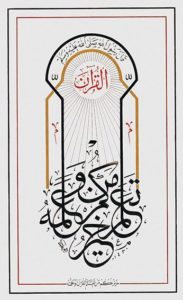




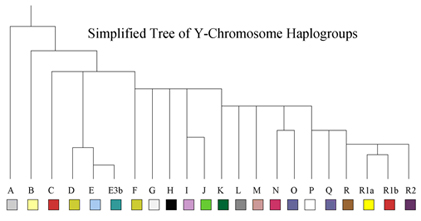

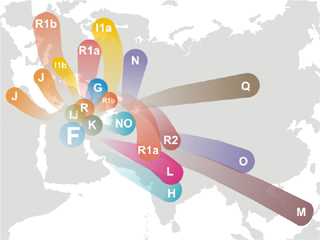
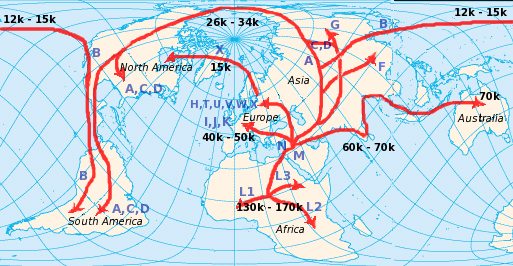
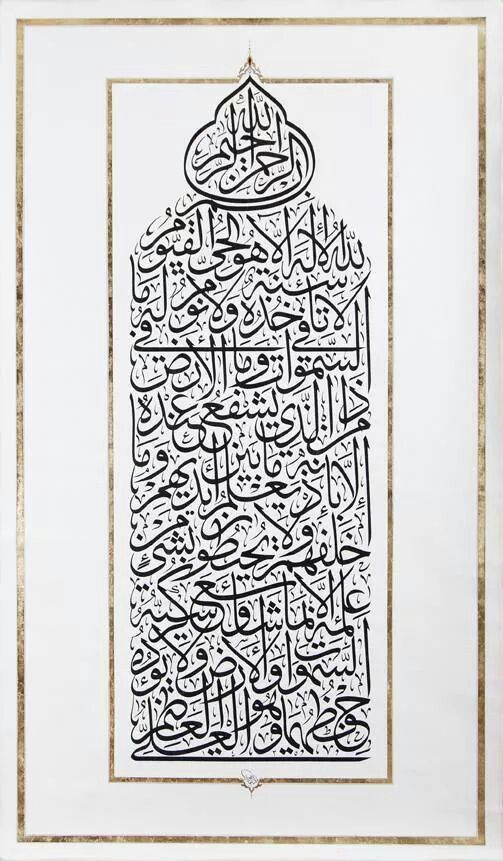







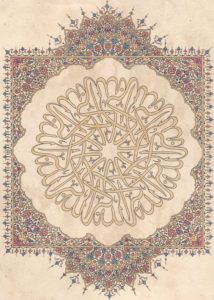
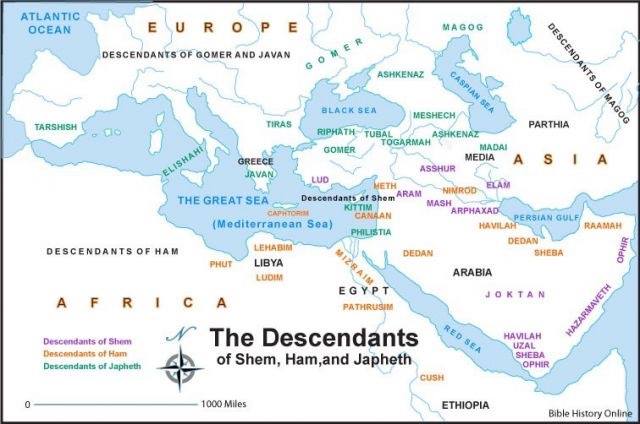
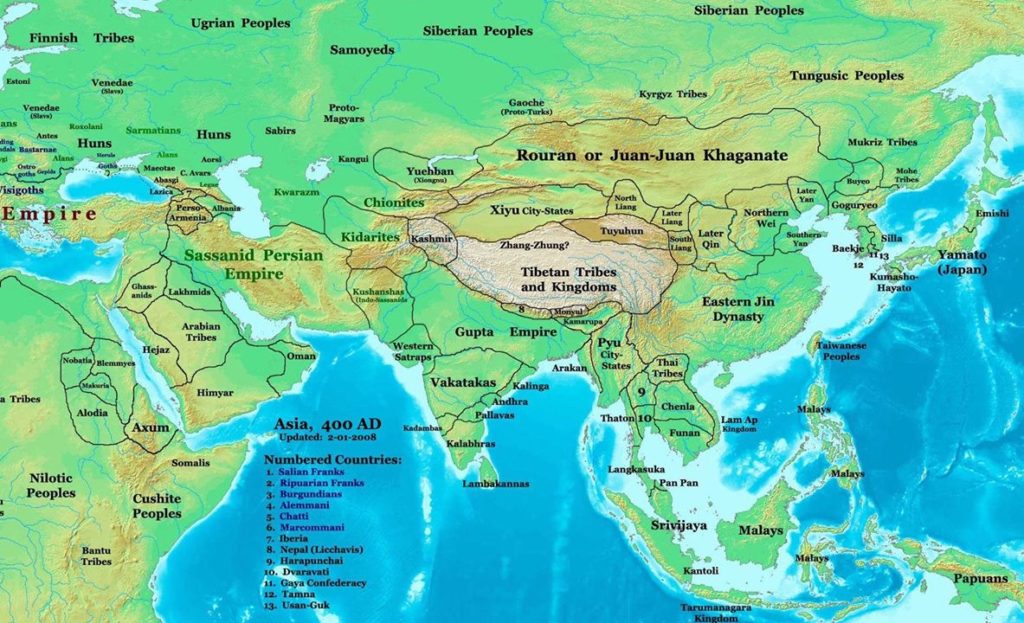


 بسم الله الرحمن الرحيم
بسم الله الرحمن الرحيم

